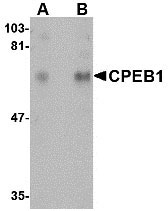CPEB1 Antibody
- SPECIFICATION
- CITATIONS
- PROTOCOLS
- BACKGROUND

Application
| WB, E |
|---|---|
| Primary Accession | Q9BZB8 |
| Other Accession | Q9BZB8, 74762720 |
| Reactivity | Human, Mouse, Rat |
| Host | Rabbit |
| Clonality | Polyclonal |
| Isotype | IgG |
| Calculated MW | 62595 Da |
| Application Notes | CPEB1 antibody can be used for detection of CPEB1 by Western blot at 1 - 2 µg/mL. |
| Gene ID | 64506 |
|---|---|
| Target/Specificity | CPEB1; |
| Reconstitution & Storage | CPEB1 antibody can be stored at 4℃ for three months and -20℃, stable for up to one year. As with all antibodies care should be taken to avoid repeated freeze thaw cycles. Antibodies should not be exposed to prolonged high temperatures. |
| Precautions | CPEB1 Antibody is for research use only and not for use in diagnostic or therapeutic procedures. |
| Name | CPEB1 |
|---|---|
| Synonyms | CPEB |
| Function | Sequence-specific RNA-binding protein that regulates mRNA cytoplasmic polyadenylation and translation initiation during oocyte maturation, early development and at postsynapse sites of neurons. Binds to the cytoplasmic polyadenylation element (CPE), an uridine-rich sequence element (consensus sequence 5'-UUUUUAU-3') within the mRNA 3'- UTR. RNA binding results in a clear conformational change analogous to the Venus fly trap mechanism (PubMed:24990967). In absence of phosphorylation and in association with TACC3 is also involved as a repressor of translation of CPE-containing mRNA; a repression that is relieved by phosphorylation or degradation (By similarity). Involved in the transport of CPE-containing mRNA to dendrites; those mRNAs may be transported to dendrites in a translationally dormant form and translationally activated at synapses (By similarity). Its interaction with APLP1 promotes local CPE-containing mRNA polyadenylation and translation activation (By similarity). Induces the assembly of stress granules in the absence of stress. Required for cell cycle progression, specifically for prophase entry (PubMed:26398195). |
| Cellular Location | Cytoplasm. Nucleus Cytoplasm, P-body. Cytoplasmic granule. Synapse. Membrane. Postsynaptic density. Cell projection, dendrite Note=Continuously shuttling between nucleus and cytoplasm (PubMed:18923137). Also found in stress granules. Recruited to stress granules (SGs) upon arsenite treatment. In dendrites (By similarity) Localizes in synaptosomes at dendritic synapses of neurons (By similarity). Strongly enriched in postsynaptic density (PSD) fractions (By similarity). Transported into dendrites in a microtubule-dependent fashion and colocalizes in mRNA-containing particles with TACC3, dynein and kinesin (By similarity). Membrane-associated (By similarity) Colocalizes at excitatory synapses with members of the polyadenylation and translation complex factors (CPSF, APLP1, TACC3, AURKA, SYP, etc.) including CPE-containing RNAs (By similarity). {ECO:0000250, ECO:0000269|PubMed:18923137} |
| Tissue Location | Isoform 1 is expressed in immature oocytes, ovary, brain and heart. Isoform 2 is expressed in brain and heart. Isoform 3 and isoform 4 are expressed in brain. Expressed in breast tumors and several tumor cell lines. |

Thousands of laboratories across the world have published research that depended on the performance of antibodies from Abcepta to advance their research. Check out links to articles that cite our products in major peer-reviewed journals, organized by research category.
info@abcepta.com, and receive a free "I Love Antibodies" mug.
Provided below are standard protocols that you may find useful for product applications.
Background
CPEB1 Antibody: CPEB1 is an RNA binding protein that contains an RNA-recognition motif and a zinc finger-containing region found in a wide range of vertebrates and invertebrates. CPEB1 forms the nucleus of a complex of factors that regulate poly(A) elongation and promotes polyadenylation-induced translation. CPEB1 mediates many diverse biological processes such as germ cell development, cell division and senescence, and synaptic plasticity. Recently, it was discovered that CPEB1 is involved in beta-catenin mRNA translation and cell migration in astrocytes as well as regulating hypoxia-inducible factor (HIF)-1 expression, demonstrating the wide range of processes in which CPEB1 plays a role. At least four isoforms of CPEB1 are known to exist.
References
Richter JD. CPEB: a life in translation. Trends in Biochem. Sci.2007; 32:179-85.
Jones KJ, Korb E, Kundel MA, et al. CPEB1 regulates beta-catenin mRNA translation and cell migration in astrocytes. Glia2008; 56:1401-13.
Hagele S, Kuhn U, Boning M, et al. Cytoplasmic polyadenylation element binding protein (CPEB)1 and 2 bind to the HIF-1alpha mRNA 3’UTR and modulate HIF-1 alpha protein expression. Biochem. J.2008; epub.
If you have used an Abcepta product and would like to share how it has performed, please click on the "Submit Review" button and provide the requested information. Our staff will examine and post your review and contact you if needed.
If you have any additional inquiries please email technical services at tech@abcepta.com.













 Foundational characteristics of cancer include proliferation, angiogenesis, migration, evasion of apoptosis, and cellular immortality. Find key markers for these cellular processes and antibodies to detect them.
Foundational characteristics of cancer include proliferation, angiogenesis, migration, evasion of apoptosis, and cellular immortality. Find key markers for these cellular processes and antibodies to detect them. The SUMOplot™ Analysis Program predicts and scores sumoylation sites in your protein. SUMOylation is a post-translational modification involved in various cellular processes, such as nuclear-cytosolic transport, transcriptional regulation, apoptosis, protein stability, response to stress, and progression through the cell cycle.
The SUMOplot™ Analysis Program predicts and scores sumoylation sites in your protein. SUMOylation is a post-translational modification involved in various cellular processes, such as nuclear-cytosolic transport, transcriptional regulation, apoptosis, protein stability, response to stress, and progression through the cell cycle. The Autophagy Receptor Motif Plotter predicts and scores autophagy receptor binding sites in your protein. Identifying proteins connected to this pathway is critical to understanding the role of autophagy in physiological as well as pathological processes such as development, differentiation, neurodegenerative diseases, stress, infection, and cancer.
The Autophagy Receptor Motif Plotter predicts and scores autophagy receptor binding sites in your protein. Identifying proteins connected to this pathway is critical to understanding the role of autophagy in physiological as well as pathological processes such as development, differentiation, neurodegenerative diseases, stress, infection, and cancer.


